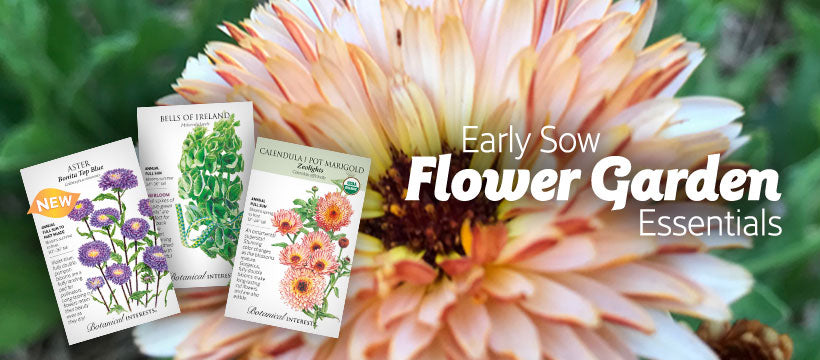Strawberries are a sweet treat to grow in your own garden and grow great in a container. Starting strawberries from seed is fun and much less expensive than buying plants, but they do take a bit of patience to get from seed to fruit. Alpine strawberries are perennial in USDA zones 5-9 and produce for a couple of years; start some new plants every year to keep a robust crop of this cute, delicious groundcover producing. If you were wondering how to grow strawberries from seed, you've come to the right place!
GENERAL SOWING
When to Sow Outside: 8 to 12 weeks before your average last frost date.
When to Start Inside: RECOMMENDED for first year fruit. 14 to 16 weeks before your average last frost date. Optimal soil temperature for germination is 60°-75°F.
Special Germination Instructions: Light aids germination; sow shallowly or press seeds into the soil surface.
INDOOR SOWING

Use a lightweight seed starting mix/medium (sterile, and lighter than potting mix), and barely cover seeds. Sow 8-10 seeds per pot, thinning to the strongest plant once two sets of leaves appear (clip extra plants at the soil level using scissors). The strongest plant may not be the tallest; look for thick, strong stems and deep color. By thinning early, you minimize the negative impact of crowding, like stretching for light. Read more about that in indoor sowing tips.
Containers
Containers should be clean, sanitized, and have drainage holes. If you choose to sow in small pots or cell packs, you may need to up-pot seedlings once into larger containers to prevent plants from becoming root-bound before transplanting outside.
Strawberries are shallow-rooted, so the width of the pot is more important than the depth. Choose a light-colored container to help keep roots cool and be sure the container has drainage holes. Use rich medium or add compost, being careful not to make the mix to heavy that it will not drain well. Do not overcrowd; stick to about 3 plants per square foot. If you are growing strawberries that produce runners, clip off the runners to boost production. Plants grown in containers are not as well-insulated as those grown in the ground so they may not overwinter. Bring pots into a protected area, like a garage, or bury the container in the ground to insulate them for the winter.
Transplanting
After hardening off, transplant seedlings 12" apart. Do not bury the crown of the plant where the leaves emerge to prevent the plant from getting too wet and possibly rotting (crown rot).

OUTDOOR SOWING
Sowing preparation and spacing
Strawberries grow best in loose, nutrient-rich soil with good drainage. Loosen dense soil using a tiller, shovel and hard rake, or other preferred method. Add compost/organic material to improve drainage. If further drainage improvement is needed you can mound soil in your growing beds prior to planting, which improves drainage. Sow 8-10 seeds every 12". Barely cover seeds; light aids germination.
Exposure
Full sun to part shade. Afternoon shade is beneficial in hot climates.Thinning
Once seedlings have 2 sets of leaves, thin to one plant every 12" by cutting plants off just above the soil.
Water
Consistently moist but not soggy. Good moisture is essential to fruit production.
Fertilization
Amend soil with compost and/or manure prior to planting if soil is deficient. A soil test is the best way to understand if and how your soil needs to be amended.
Weeding
Keep plants well weeded. Weeds compete with crops for light, nutrients, and water, and can harbor insects and diseases.
Special care
Mulching plants with several inches of material like leaves, straw, or wood chips reduces weeds, keeps fruit cleaner, and keeps plants consistently moist. Keep deep mulch away from the crown of the plant, to keep it from being too wet. Creating a low tunnel using chicken wire is a great way to protect your fruit from birds and squirrels.
HARVESTING

Harvest fruit in the morning for longest storage. Allow strawberries to fully ripen on the plant for best flavor. When alpine strawberries are ripe, they are highly fragrant, and the red types are fully colored. Gently pull or snip ripe fruit from the plant, keeping the green top on the fruit. Strawberry fruit is fragile; handle gently.
STORAGE
Store unwashed, dry strawberries in a sealed container in the refrigerator for up to one week.
COMMON PESTS AND DISEASES
Strawberries are susceptible to several pests and diseases, many of which are regional. Your local Cooperative Extension or independent garden center are excellent resources for regional pest and disease identification and control. Here is some guidance for some common issues:
Fungal diseases like leaf spot, gray mold, and powdery mildew can be prevented by using clean mulch, reducing water splashing (e.g. use drip irrigation), removing dead and infected leaves, and anti-fungal preventative sprays like copper, sulfur, or milk prior to infection and wet weather. Read more about organic pest and disease management.
Be sure to monitor plants for insect damage, webbing, fungal spots, misshapen fruit, or other signs of damage often. Create beneficial insect habitat adjacent to your strawberry planting to invite a healthy predatory insect population to help keep any pests in check. Many beneficial insects are small, and small, flat or umbel-shaped flowers are easier for them to access. Some examples of flowers that attract beneficial insects are dill, alyssum, cilantro, lavender, fennel, and yarrow.


